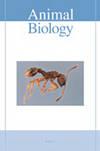两个池塘中西食蚊鱼(Gambusia affinis)食性的变化:时间和与中央鱼类共存的影响
IF 0.9
4区 生物学
Q2 ZOOLOGY
引用次数: 0
摘要
摘要西方食蚊鱼(Gambusia affinis)已被引进到世界各地,并通过竞争和捕食对本地鱼类产生影响。因此,食材可能决定了它们与本地物种相互作用的程度。我们于2010年、2015年和2016年在俄亥俄州中部的两个池塘中检测了G. affinis的胃内容物。在Olde Minnow Pond,我们收集了2014年引入本地太阳鱼Lepomis megalotis前后的饮食数据。我们还收集了木鸭池中同一时期的G. affinis数据,该池在研究期间之前已含有G. affinis和Lepomis macrochirus多年。主要的猎物是浮游动物,尤其是Chydorus sp.和Alona sp.。胃中经常发现水生昆虫,特别是摇尾虫的幼虫,其重要性逐年变化。2010 - 2015年,老米诺鱼池中附体溞(G. affinis)的相对浮游动物摄取量急剧增加,尤其是雌性,但在2016年有所下降。此外,与2010年相比,巨尾鲤到来后,老鲦鱼池中水生昆虫的相对消费量有所增加。与此相反,在整个研究期间,木鸭池内的食材保持相对相似。老鲦鱼塘雄性和雌性的食材不同,而木鸭塘雄性和雌性的食材基本相似。综上所述,本自然试验结果为巨斑乳杆菌进入老鲦鱼池后对其食性的影响提供了间接证据。本文章由计算机程序翻译,如有差异,请以英文原文为准。
Variation in the diets of western mosquitofish (Gambusia affinis) in two ponds: effects of time and coexistence with centrarchid fishes
Abstract Western mosquitofish, Gambusia affinis , have been introduced around the world, and can affect native fish through competition and predation. The diet of G. affinis may therefore determine the extent of their interactions with native species. We examined stomach contents of G. affinis from two ponds in central Ohio in 2010, 2015, and 2016. In Olde Minnow Pond, we collected diet data before and after the introduction of the native sunfish, Lepomis megalotis , in 2014. We also collected data for G. affinis for the same period in Wood Duck Pond that has contained G. affinis and Lepomis macrochirus for years prior to the study period. The most important prey were zooplankton, especially Chydorus sp. and Alona sp. Aquatic insects, especially chironomid larvae, were often found in stomachs, with their importance varying by year. The relative consumption of zooplankton increased dramatically in G. affinis , especially females, in Olde Minnow Pond from 2010 to 2015 but then dropped in 2016. In addition, the relative consumption of aquatic insects increased in Olde Minnow Pond after the arrival of L. megalotis compared to 2010. In contrast, the diets of G. affinis in Wood Duck Pond remained relatively similar across the study period. Male and female G. affinis in Olde Minnow Pond had different diets, whereas the diets of males and females in Wood Duck Pond were generally similar. In conclusion, the results of this natural experiment provide circumstantial evidence that the arrival of L. megalotis in Olde Minnow Pond affected the diet of G. affinis .
求助全文
通过发布文献求助,成功后即可免费获取论文全文。
去求助
来源期刊

Animal Biology
生物-动物学
CiteScore
2.10
自引率
0.00%
发文量
34
审稿时长
3 months
期刊介绍:
Animal Biology publishes high quality papers and focuses on integration of the various disciplines within the broad field of zoology. These disciplines include behaviour, developmental biology, ecology, endocrinology, evolutionary biology, genomics, morphology, neurobiology, physiology, systematics and theoretical biology. Purely descriptive papers will not be considered for publication.
Animal Biology is the official journal of the Royal Dutch Zoological Society since its foundation in 1872. The journal was initially called Archives Néerlandaises de Zoologie, which was changed in 1952 to Netherlands Journal of Zoology, the current name was established in 2003.
 求助内容:
求助内容: 应助结果提醒方式:
应助结果提醒方式:


